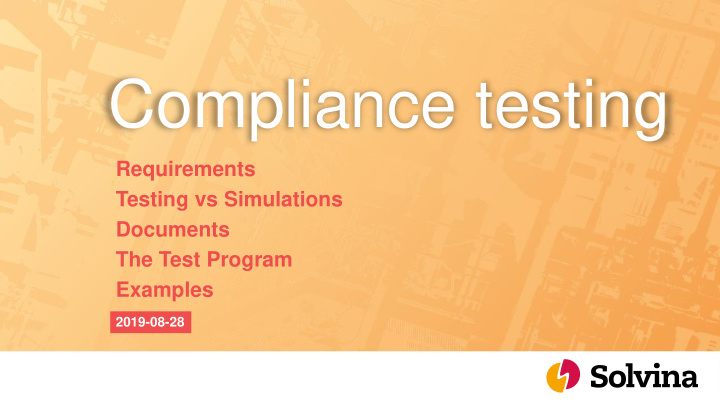



Compliance testing Requirements Testing vs Simulations Documents The Test Program Examples 2019-08-28
• Sven Granfors Managing Director, Solvina International • Sven.Granfors@solvina.com • +46 708 72 10 86 • • M. Shahzad Alam Managing Director, Solvina India • Shahzad.Alam@solvina.com • +99 10 61 11 84 •
Solvina International Providing reliable power to nations and industries Swedish engineering company 20 years 1000 projects 200 customers 25 countries
Requirements Why is there a grid code? Grid operation and production are separated in many countries The grid operator must rely on the production The production must rely on the grid Equal and predictable business for all producers
Requirements Why is there a grid code? Robustness – plants must stay in operation in difficult conditions to avoid blackout Controllability – the grid operator must be able to decide the operation according to grid demands Stability support – plants should help keeping the grid stable according to their ability or as per agreement
Requirements Why is there a grid code? Safety – must limit operation to a safe range to protect the plant Safety – must disconnect if there is a serious problem, to protect both the grid and the plant from damage ..obviously, these requirements collide
Testing vs Simulation Some properties are better to simulate Often, an extensive simulation study is required before the plant is built Testing would risk damage – e g fault handling Testing would cause grid instability Testing would give dubious results – e g Power Quality Testing is practically impossible – lightning transients
Testing vs Simulation Some properties are better to test Testing may be required to confirm the simulation models Simulating would never cover everything – e g house load When external equipment is involved Functions that are critical for grid stability and should be double checked – e g excitation limiters Some properties may just be easier to test
Testing vs Simulation but... There are things that can neither be simulated nor tested reliably, e g Frequency range at full load ROCOF capability
The Test Program Purpose Describing how to perform the tests To be agreed upon by involved parties Often initiating the discussions – better early in the project Accepted by TSO as being sufficient for showing compliance – no further tests Accepted by supplier as being necessary for showing compliance – no less tests
The Test Program Structure General test conditions Measurement/recording Description of each test Conditions Execution, step by step Signals to be measured and sampling rate Success criteria
Technical considerations Signal preparation Shielded cables Shield grounded in ‘power plant’ end Avoid mixing signal types in one cable Exciter voltage/current may need filtering
Technical considerations
Technical considerations
Examples Test examples Overall tests Load rejection House load Over/under frequency Over/under voltage Fault ride through Cold start & startups Black start Reliability Power quality
Examples FRT Short circuit applied in HV substation
FRT – compare to requirements Not really possible to test
Examples Black start – transformer energising Transformer breaker closed – inrush current • Harmonics • Imbalance • DC component
Examples Load rejection & house load Generator breaker opened
Examples Test examples Excitation & generator tests Excitation response Excitation limiters PSS performance On/off tests Frequency response Voltage and reactive power control Reactive capability Generator data verification
Examples Excitation response Inject steps into voltage reference.
Examples Excitation limiters Increasing MVAr setpoint until limiter is activated
Examples Reactive capability MVAr setpoint up/down until limiter is activated
Examples Test examples Governor & prime mover tests Power capability Power control Primary frequency response Frequency control Island operation Efficiency Fuel switching
Testing Primary control Tested while grid connected Often a part of Grid code testing Apply a small step or ramp to the frequency Dynamics are seen poorly
Testing Island operation testing – general Run the unit (or plant) islanded Apply load steps up and down Record the frequency deviation From that, determine the permissible load step contained within a certain frequency range
Testing Load bank method Run the plant as an island, connected to a resistor bank Advantage: the plant is actually islanded, so all systems are included in the test Expensive and impractical method, in many cases also risky Not feasible for large plants Step size may be restricted
Testing Load bank method – this is what 16 MW looks like
Testing The Solvina method Run the plant connected to the main grid ...but replace the speed/frequency signal read by the governor Safe, flexible and inexpensive method
Testing The Solvina method Actual turbine speed is not changed Island operation can be aborted at any time Governor tuning can be performed easily Find the limits and margins in a safe way Malfunctioning equipment can be identified
Testing Solvina method – this is what Hundreds of MW looks like
Testing
Results Finding plant capability
Results Safety START ABORT
Results Tuning - before
Results Tuning - after
• Sven Granfors Managing Director, Solvina International • Sven.Granfors@solvina.com • +46 708 72 10 86 • • M. Shahzad Alam Managing Director, Solvina India • Shahzad.Alam@solvina.com • +99 10 61 11 84 •
solvina.com
Recommend
More recommend